Opening Letter
Friends and Colleagues,
2019 marked the 10th anniversary of the Division of Ecological Restoration’s founding. This report celebrates the progress that we and our partners have made, the lessons we’ve learned, and the challenges and opportunities ahead.
Leaders in the Department of Fish and Game and the Executive Office of Energy and environmental Affairs formed DER in 2009 to bring greater attention, momentum, and capacity to river and wetland restoration statewide.
Now, ten years later, the Division and its partners have completed over 65 projects and developed extensive knowledge and expertise to support the rapidly expanding demand for restoration and climate adaptation work. Our work includes dam removal, culvert replacement, wetland and floodplain restoration, urban river revitalization, and streamflow and water quality restoration.
In 2019, to meet the rising demand, we added four new staff to increase our ability to help partners plan and implement projects. In 2020, we will fortify our internal operations and expand assistance to help regional and watershed organizations lead and support restoration. With support from DER, these organizations will accelerate the pace of ecological restoration while also helping communities increase their resilience to climate change.
All of our work takes place through strong partnerships with communities, state and federal agencies, regional organizations, and non-profit groups. We believe that this is the best way to get restoration done. Our partnerships helped make DER’s first ten years a resounding success, and they will continue to be the driving force for expanding restoration benefits in the decade ahead.
Sincerely,
Beth Lambert, Director
Hunt Durey, Deputy Director
Ronald S. Amidon, Commissioner
Mary-Lee King, Deputy Commissioner
2019 Accomplishments
- DER leveraged over $8.7 million in newly awarded external funds for community-based restoration projects. The grants pay for engineering, design, and construction work taking place in communities across the Commonwealth.
- DER helped municipal staff, watershed groups, landowners, and other organizations in more than 148 communities through trainings, site visits, one-on-one assistance, grants, projects, and other types of assistance.
- Volunteers devoted more than $30,900 worth of labor towards DER river and wetland restoration projects.
- DER launched the Water Quality Restoration Pilot Program to help communities and watershed organizations reduce or prevent water quality impairments.
- The Culvert Replacement Municipal Assistance Program, begun in 2017, awarded $2.5 million in grants to 36 towns in its first three years. Grants help towns upgrade road-stream crossings to provide fish passage, habitat continuity, and resilience to large storms. 3 projects have been constructed and completed.
- DER’s Cranberry Bog Program advanced 7 priority projects, responded to 16 inquiries about potential projects (launching initial studies for 7), and made presentations touching over 500 people on the benefits of restoring wetlands on retired cranberry bogs.
- DER completed 2 river and wetland restoration projects in Kingston and Newbury and began construction on 3 others located in Pittsfield, Falmouth and Yarmouth. Together these projects remove 2 dams, replace 2 bridges, replace 1 culvert, reconnect 31.2 miles of river, and restore 314 wetland acres. Progress continued on 54 other habitat restoration projects.
10 Years of Accomplishments With our Partners
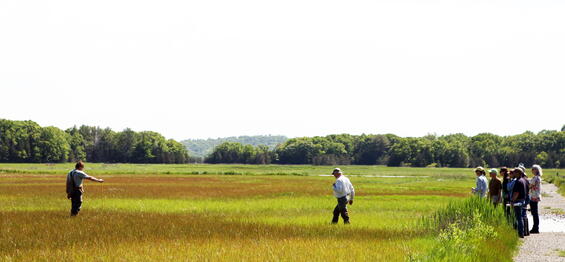
DER is partnering with the Trustees for Reservations to undo legacy impacts of agriculture on salt marshes.
In celebration of DER’s 10th anniversary, here is a snapshot of what we’ve accomplished working together with federal, state, municipal, private, and non-profit partners:
- Removed 50 dams to re-connect 300 river miles and restored 2,400 acres of wetlands.
- Established the Stream Continuity Program to help municipalities replace undersized or failing culverts with larger, safer structures that provide passage for fish and wildlife.
- Launched the Cranberry Bog Program to restore wetlands on retired cranberry farmland. The program brings resiliency benefits as well as new open space and recreation opportunities.
- Built an entrepreneurial streamflow restoration program to develop new approaches for restoring natural streamflow in flow-stressed rivers.
- Advanced urban river revitalization, with habitat improvement and public access projects in Fitchburg, Lawrence, Chicopee, and North Adams and with dam removals in former industrial centers such as Taunton and Pittsfield.
- Worked in over 200 communities per year, providing technical assistance, grants, site assessments, engineering studies, and other services.
- Secured over $90 million in federal, foundation, private, and other non-state funding for restoration projects.
In pursuit of the accomplishments above, we’ve learned many lessons which we will carry forward to meet the increasing demand for restoration and the challenges of climate change. Here are four of our top lessons learned from DER’s first decade:
- Rivers and wetlands can recover quickly from past damage when key stressors are reduced or removed. For those who witness the results, seeing a river or wetland recover from past damage brings hope, a sense of accomplishment, and a visceral reminder that taking action can lead to positive change.
- Restoration has powerful co-benefits such as improved public safety, job creation, outdoor recreation, economic benefits, and others. These benefits attract diverse coalitions of restoration advocates and partners
- Communities and landowners are eager to do restoration work and recognize the link between restoration and climate adaptation. Most, however, do not have the capacity and need significant and sustained technical and financial assistance.
- The scale and the scope of restoration needs can only be met by building capacity and partnerships across the state and throughout all levels and types of organizations. DER is most effective as a leader, teacher, catalyst, helper, and facilitator to help others take up the restoration cause.
DER’s Vision for the Next 10 Years
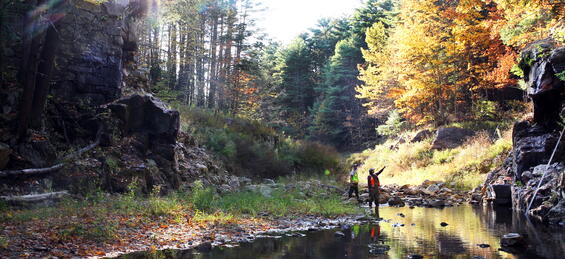
The Upper Roberts Meadow Brook Dam Removal site, one year after removal.
DER is gearing up to expand the pace and scale of ecological restoration and climate adaptation work across the Commonwealth. We have identified two overarching priorities for the years ahead:
First, we will expand our direct leadership and support for partnership-based projects. Our initial goal is to double the number of river and wetland restoration projects DER is supporting. We will focus on high-value projects that provide significant benefits to people and nature such as dam removal and culvert replacement. In addition, we will increase support for emerging restoration and climate adaptation needs and opportunities. These include retired cranberry farmlands, water quality impairments, and coastal wetland resilience to sea level rise.
Second, we will help build the capacity of others to lead and support restoration-adaptation actions. The need and demand for restoration and climate adaptation assistance is growing rapidly. Regional and watershed organizations are well-positioned to help communities meet these needs, and many are seeking to build their capacity to do so. Meanwhile, DER has developed expertise and a body of knowledge about all aspects of the restoration process, from planning and design to permitting and construction. We will distill and share this knowledge with organizations that can use it to lead and support restoration regionally and locally.
To further advance this second priority, we will pilot a new Regional Restoration Partnerships Program that will establish and fund formal DER partnerships with regional organizations. The goal of these partnerships is to build regional capacity and resources to help communities and others plan and carry out high value restoration-adaptation projects. This new program will start small and, if proven effective, grow over time.
Governor Baker, in his January 2020 State of the Commonwealth address, highlighted the importance of helping communities proactively address the future threats of climate change. Communities and citizens across Massachusetts are signaling a strong desire for action. We invite you to join DER in redoubling efforts to help nature and people restore ecosystem health and build climate resilience. In doing so together, we can forge a hopeful vision for our collective future.
Dam Removal Builds Resilience in Pittsfield
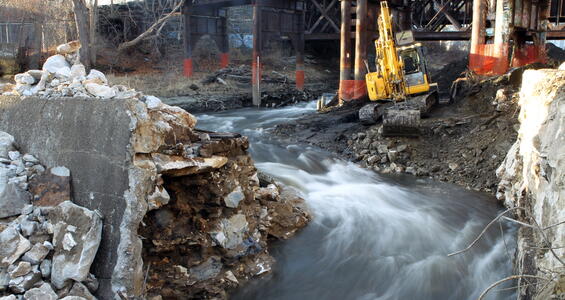
Work to remove the Tel-Electric Dam started in the fall.
After more than a decade of planning and assessment, we’re thrilled to see the project advancing. When completed, the project will not only help restore the natural flows within the river but also remove an outdated piece of infrastructure and the polluted sediments that have been held behind it for decades.
~ James McGrath, City of Pittsfield
The Tel-Electric Dam (also known as the Mill Street Dam) in Pittsfield has stood on the West Branch of the Housatonic River for more than a century. In recent years, the dam has fallen into disrepair and no longer serves a useful purpose. It also is a safety hazard for the community and contributes to local flooding during storms.
DER has been working with the City of Pittsfield, the private dam owner, and other partners for over 10 years to plan the removal of this dam. Deconstruction of the dam began this fall. Removing the dam reconnects nearly five miles of upstream river habitat with the lower reach of the West Branch Housatonic River.
This dam removal is part of the City of Pittsfield’s larger efforts for a clean, resilient, free-flowing West Branch of the Housatonic River that connects two local parks and increases residents’ access to the river. With the dam gone, kayaking and canoeing will be possible. The City envisions a new trail past the former dam as part of a river greenway.
Support for the project comes from the National Fish and Wildlife Foundation, the U.S. Department of the Interior Office of Restoration and Damage Assessment, Massachusetts Executive Office of Energy and Environmental Affairs Dam and Seawall Repair or Removal Fund and the MVP Program, the Massachusetts Department of Environmental Protection, the Massachusetts SubCouncil of the Housatonic River Trustee Council, the City, and the dam owner.
Streamflow Restoration Balances Multiple Uses on Stony Brook
Installation of a stop log with a low flow outlet will enable low flow releases from Spectacle Pond.
The Stony Brook Streamflow Restoration project is a great example of how we can use some cool technology that is readily available nowadays to balance the needs of water supply, aquatic recreation, and instream flow. DER has been very forward-thinking in their work with water suppliers throughout the commonwealth and Littleton is incredibly fortunate to have their support on this project.
~ Corey Godfrey Town of Littleton
Stony Brook and its tributaries run 20 miles through three towns and past six dams. In the summer, when rivers and streams are at their lowest, flow in the Stony Brook has been described to be “reduced to a ‘trickle.’” Even this year, when Massachusetts had a relatively wet summer, flow in the Stony Brook was unnaturally low.
Dam management, water withdrawals, and land use all alter streamflow in the Stony Brook watershed. This impacts water quality and the fish and insects that live in the stream, as well as recreation and water supply. The Stony Brook Restoration Project is one of many projects currently underway that seek to balance the needs of aquatic ecosystems with water supply, recreation, and other uses. A few years ago, the towns of Littleton and Westford came together to improve stream conditions in Stony Brook. In 2019, DER accepted the Stony Brook Streamflow Restoration as a Priority Project.
The goal of the restoration project is to conduct coordinated flow releases at the dams that blanket the Brook. This means when streamflow is lower than normal, water will be released from behind the dams to supplement downstream flow. The towns, along with DER, tested releases at two of the dams this past summer to great success. These releases were able to increase streamflow downstream to help fish and wildlife without impacting recreational use or habitat in the upstream impoundments.
DER will be tracking improvements to the fish and stream insect communities, but its too early to assess those impacts. This innovative approach will result in a healthier and more resilient watershed and can serve as a model for other communities looking to improve streamflow.
Culvert Upgrade Benefits Trout and the Traveling Public in Mashpee
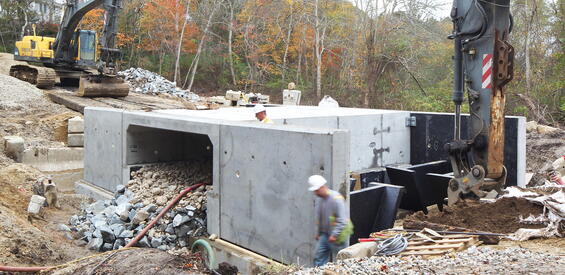
Replacement of the undersized culvert on Sampson’s Mill Road in Mashpee is underway.
The DER grant positioned the Town to be able to apply for construction funding from NRCS/ USDA. Spending deadlines associated with the NRCS funding required the project to be “shovel ready”. Because of the DER grant, design and permitting had been completed and the Towns of Mashpee and Barnstable, who jointly own the culvert, received 75% construction funding or almost $625,000 from NRCS.
~ Catherine Laurent Town of Mashpee
DER’s Culvert Replacement Municipal Assistance Grant Program combines incentive funding with hands-on technical assistance to help communities replace undersized and failing culverts with larger, safer structures that provide passage for fish and wildlife. As demonstrated by the Santuit River Culvert Replacement Project, early-stage technical assistance and funding from DER can position communities for federal or state grants for construction in future years.
The Santuit River in eastern Mashpee provides critical habitat for river herring and sea-run brook trout. However, fish in the Santuit River are subject to multiple threats, including undersized culverts that block fish passage. Brook trout populations have declined as a result.
In 2018, DER provided a Culvert Replacement Municipal Assistance grant to the Town of Mashpee to develop design and engineering plans to replace the undersized Sampson’s Mill Road crossing. This year, with substantial funding from NRCS/USDA, the town installed the upgraded culvert and completed other stormwater improvements.
The new culvert allows for the Santuit river to flow naturally and brook trout (and other fish and wildlife) to access critical habitat in the Santuit River and the nearby estuary. MassWildlife has also made habitat improvements and re-introduced eastern brook trout to the Santuit River.
Fearing Brook Restoration Will Improve Water Quality
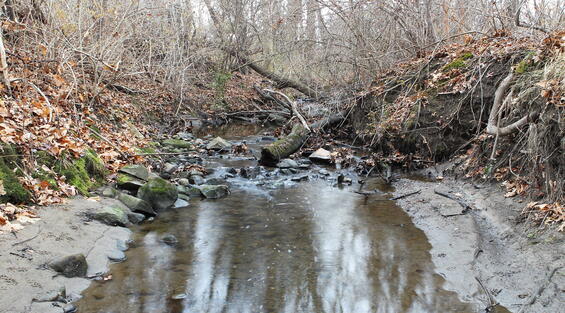
Fearing Brook and its eroding and unstable banks.
The Fearing Brook floodplain reconstruction project means a lot to me. It's the cumulation of five years of data collection and study by Amherst in partnership with DER. The goal of that work was always protection of the Fort River, a river that my kid's classes and camps have visited to learn about river ecosystems. The removal of sediment, nutrients, and bacteria from the waters of the Fearing Brook by this constructed floodplain will improve and protect Amherst's beloved Fort River.
~ Beth Wilson, Environmental Scientist, Town of Amherst
Emily Dickinson may have played along the banks of Fearing Brook as a child as the stream flowed just downslope from the family home. By the time of her death, in the 1880’s, the brook of her childhood had been moved and buried to make way for new homes and the expanding campus of Amherst College. Today, Fearing Brook remains mostly buried beneath downtown Amherst with pipes carrying the brook - swelling to near bursting when there is a heavy rain - and the detritus of the urban landscape to the Fort River downstream.
Where Fearing Brook is visible, it exhibits ‘urban river syndrome’, including eroded and unstable banks, poor water quality and a lack of healthy habitat. The town of Amherst is working with DER to improve water quality, stream stability, and appreciation for this hidden downtown waterway.
Following an assessment of conditions in Fearing Brook, funded by DER, the town prioritized one of the recommended restoration opportunities, a floodplain reconnection, advancing this to a more complete design. This work allowed the town to apply for and be awarded the necessary construction funding. Construction will take place in 2020.
The floodplain reconnection project is located just before Fearing Brook flows into Fort River. The project will remove dredge material that has been piled in high banks along the river. This will allow Fearing Brook to once again spill out onto its floodplain. The scientific literature suggests there will be significant water quality gains when the stormwater-swollen brook once again accesses its naturally vegetated floodplain. The floodplain will also provide a greater area for stormwater infiltration - comparable to many engineered stormwater mitigation structures. The water quality and habitat gains will be particularly important to the Fort River downstream which supports a federal and state listed endangered species.
Wetlands Restoration and Adaptation in Yarmouth
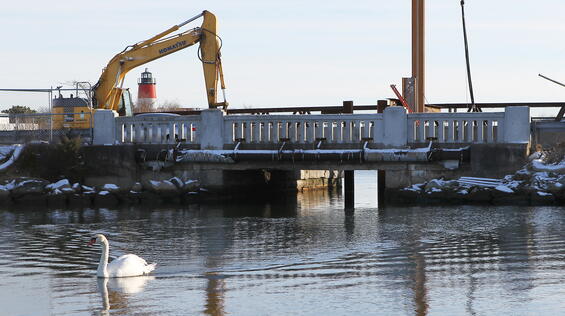
Work underway to replace the undersized tidal crossing on Route 28 in Yarmouth.
While the heaviest part of the lift occurred over the past decade, the key benefit to the completion of this infrastructure improvement is the minimal operation and maintenance for the future. Nature will provide its own healing to the environment under this bridge. It is a real win when a project can bring multiple benefits to the community – both improvements to infrastructure and multiple benefits to the natural environment. The Town is appreciative of all its partners and their continued efforts to bring this project into construction.
~ Amanda Ruggiero, Town of Yarmouth
After more than 10 years of investigating feasibility, planning, designing, permitting, and coordination, construction to replace the Parkers River Bridge in Yarmouth is now underway. The goal of the project is to restore tidal flow to the 219 acre estuary and its wetlands. The project will also reduce flooding on the inland side of the bridge and improve road safety.
The Parkers River in Yarmouth flows south from Seine Pond, under the Route 28 roadway, and then into Nantucket Sound. The undersized crossing at Route 28 divides the Parkers River estuary and has restricted flow into the upper estuary for over 120 years. Water quality concerns in Seine Pond in the upper reach of the river have been reported for years. Restrictions to the natural tide have also reduced the supply of natural sediments that are carried in, a critical function which helps marshes accrete and build marsh peat. This impacts the health of the marsh and its ability keep pace with sea level rise. During storms, high waters trapped on the outgoing tides cannot dispel fast enough and are a concern for the town and citizens.
This fall, the Town and project partners kicked off construction to replace the undersized 18-ft long degraded crossing with a bridge that nearly doubles the existing span and allows for optimal tidal exchange. Improvements to pedestrian safety were also an important component of the project. Work is expected to be completed by fall of 2021. Maintaining vehicular and pedestrian access along Route 28 has been critical for project work and is the reason for the extended schedule.
Once in place, the natural tidal flow will be restored, improving the ecosystem health of the 219-acre estuarine system. The additional flushing will also assist the Town in their wastewater efforts by reducing the amount of nitrogen required to be removed by this watershed by 30 percent.
Partners on this project include the Town of Yarmouth, MassDOT, NRCS, Cape Cod Conversation District, Association to Preserve Cape Cod, the NOAA Restoration Center, and the USFWS.
2019 Highlights
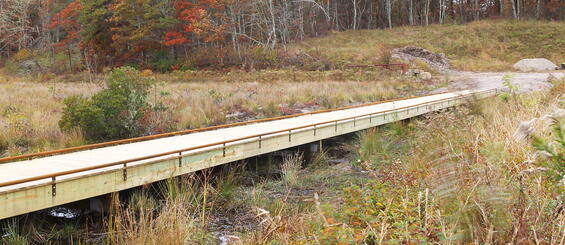
The Coonamessett River Restoration Project included construction of this new accessible boardwalk.
In 2019, DER continued to advance 56 on-the-ground river and wetland restoration projects. DER also continued to advance statewide initiatives and technical assistance. Highlights from 2019 include:
Adamsville Road Culvert Replacement (Colrain) DER provided Culvert Replacement Municipal Assistance grant funding to the Town of Colrain to replace an undersized culvert on an un-named tributary to the North River. Construction was completed in spring and provides improved passage for fish and wildlife. DER provided funding in 2018 for data collection and initial engineering and design.
Jones River Restoration, Elm Street Dam Removal (Kingston) After 300 years, the Jones River is now flowing freely at Elm Street. Construction on the removal of this dam was completed this fall. Located at the head of tide (first dam from the ocean), removal of the dam restores connectivity to over 24 miles of river habitat. Partners included the Jones River Watershed Association, the Town of Kingston, Division of Marine Fisheries, MassWildlife, National Marine Fisheries Service, NOAA, and MassDEP.
Water Conservation Toolkit (Statewide) This year DER partnered with MassDEP to release the Healthy Lawn, Happy Summer toolkit to help communities implement water conservation campaigns in the summer. MassDEP, DER, and DCR have been working with several Massachusetts communities to develop and pilot water conservation campaigns that reduce summer water use. The toolkit provides water suppliers with everything they need to start their own campaigns.
Coonamessett River Restoration (Falmouth) DER, NOAA, the Town of Falmouth, Coonamessett River Trust, and partners broke ground on Phase 2 of the Coonamessett River Restoration this year. Building on the first phase completed last year, this phase of this restoration project will restore the remaining 26 acres of the former cranberry bog.
Water Quality Program (Statewide) DER has worked with experts in the field of water quality and communications to develop the Water Quality Restoration Program Framework. The Framework is a process designed to guide communities and organizations through the steps needed to identify feasible water quality improvement and protection goals, build the resources they need to meet their goals. DER provided a grant to the Ipswich River Watershed Association to pilot the new Framework to see how well the Framework performs and help ensure it is user-friendly and useful.
Kent’s Island Creek Restoration (Newbury) MassWildlife has completed work to install a new bridge at the Kent’s Island Salt Marsh, part of the William Forward Wildlife Management Area in Newbury. The new bridge restores tidal flow to the 47 acre coastal salt marsh and provides improved safe access for wildlife management activities including management of shrub and grasslands. DER provided technical assistance and funding in support of this work. The project was also supported through a USFWS NAWCA Grant.
Valley Road Culvert Training Site (Boxford) Since 2017, DER has been supporting the Town of Boxford’s efforts to replace an undersized culvert on a tributary to the Parker River with a structure meeting improved stream crossing and engineering design standards. With design and permitting complete, DER provided funding this year for installation of the new culvert, expected to be complete by June 2020. This site is part of our network of training sites across the Commonwealth.